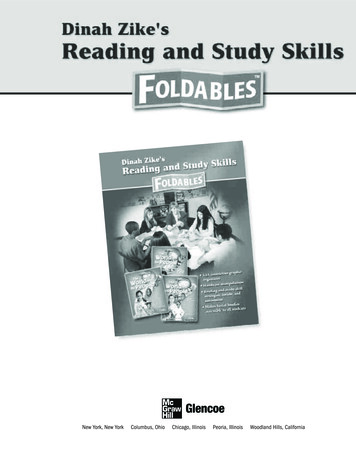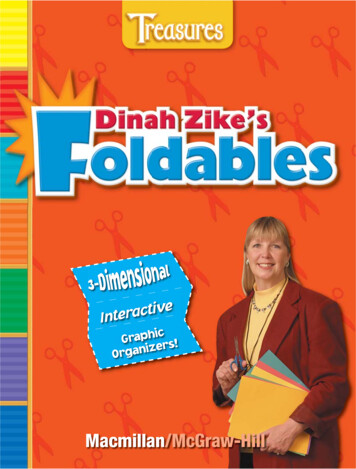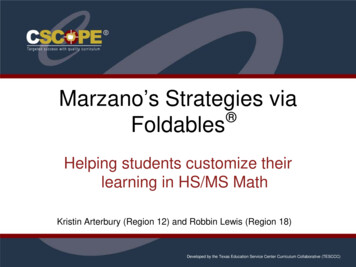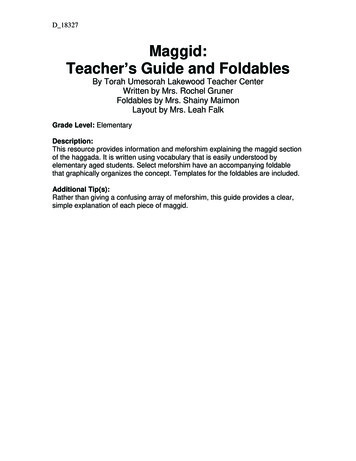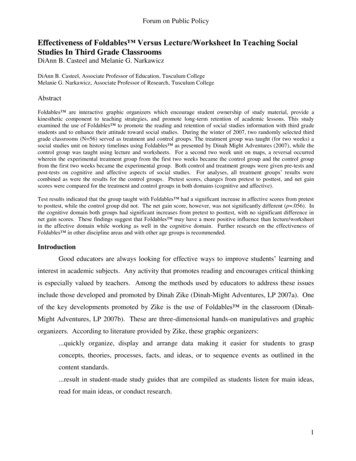
Transcription
Forum on Public PolicyEffectiveness of Foldables Versus Lecture/Worksheet In Teaching SocialStudies In Third Grade ClassroomsDiAnn B. Casteel and Melanie G. NarkawiczDiAnn B. Casteel, Associate Professor of Education, Tusculum CollegeMelanie G. Narkawicz, Associate Professor of Research, Tusculum CollegeAbstractFoldables are interactive graphic organizers which encourage student ownership of study material, provide akinesthetic component to teaching strategies, and promote long-term retention of academic lessons. This studyexamined the use of Foldables to promote the reading and retention of social studies information with third gradestudents and to enhance their attitude toward social studies. During the winter of 2007, two randomly selected thirdgrade classrooms (N 56) served as treatment and control groups. The treatment group was taught (for two weeks) asocial studies unit on history timelines using Foldables as presented by Dinah Might Adventures (2007), while thecontrol group was taught using lecture and worksheets. For a second two week unit on maps, a reversal occurredwherein the experimental treatment group from the first two weeks became the control group and the control groupfrom the first two weeks became the experimental group. Both control and treatment groups were given pre-tests andpost-tests on cognitive and affective aspects of social studies. For analyses, all treatment groups’ results werecombined as were the results for the control groups. Pretest scores, changes from pretest to posttest, and net gainscores were compared for the treatment and control groups in both domains (cognitive and affective).Test results indicated that the group taught with Foldables had a significant increase in affective scores from pretestto posttest, while the control group did not. The net gain score, however, was not significantly different (p .056). Inthe cognitive domain both groups had significant increases from pretest to posttest, with no significant difference innet gain scores. These findings suggest that Foldables may have a more positive influence than lecture/worksheetin the affective domain while working as well in the cognitive domain. Further research on the effectiveness ofFoldables in other discipline areas and with other age groups is recommended.IntroductionGood educators are always looking for effective ways to improve students’ learning andinterest in academic subjects. Any activity that promotes reading and encourages critical thinkingis especially valued by teachers. Among the methods used by educators to address these issuesinclude those developed and promoted by Dinah Zike (Dinah-Might Adventures, LP 2007a). Oneof the key developments promoted by Zike is the use of Foldables in the classroom (DinahMight Adventures, LP 2007b). These are three-dimensional hands-on manipulatives and graphicorganizers. According to literature provided by Zike, these graphic organizers:.quickly organize, display and arrange data making it easier for students to graspconcepts, theories, processes, facts, and ideas, or to sequence events as outlined in thecontent standards.result in student-made study guides that are compiled as students listen for main ideas,read for main ideas, or conduct research.1
Forum on Public Policy.provide a multitude of creative formats in which students can present projects, research,experiment results, and inquiry based reports instead of typical poster board or science fairformats.replace teacher-generated writing or photocopied sheets with student-generated print.incorporate such skills as comparing and contrasting, cause and effect, and similaritiesand differences into daily work and long-term projects. For example, these graphicorganizers can be used to compare and contrast student explanations of inquiry basedquestions to explanations currently accepted by scientists.continue to "immerse" students in previously learned vocabulary, concepts,generalizations, ideas, theories, etc. providing them with a strong foundation upon whichthey can build with newly learned knowledge, observations, and concepts.can be used by students or teachers to easily communicate data through graphics, tables,charts, diagrams, models and Venn diagrams.allow students to make their own journals for recording qualitative and quantitativeobservations.Can be used as alternative assessment tools by teachers to evaluate student progress or bystudents to evaluate their own progress.integrate language arts, social studies, mathematics, and science.provide a sense of student "ownership" or investiture in the curriculum. (Dinah-MightAdventures, LP 2007c, 2)Although there is much commercial information regarding the use of Foldables in theclassroom, experimental, peer reviewed studies of their effectiveness were not found in anextensive review of the literature. Anecdotal evidence was prevalent on the internet with somehome-school parents finding these particularly useful and some even giving specific examples ofuses (“Using”, 2004). Some of Zike’s books of activities have been favorably reviewed as well(Angus 1993; Landis 1994; Pearce 1994; “And the Winners Are” 1996), however, no studies ofthe effectiveness of Foldables were discovered. This study, therefore, examined the use ofFoldables in third grade classrooms. Specifically, comparisons (on cognitive and affectiveassessment measures) were made between those taught using Foldables and those taught usinglecture with worksheets.2
Forum on Public PolicyMethodsThis study took place in the winter of 2007 in an elementary school in a rural communityin East Tennessee. Manufacturing and retail are the major area employers and residents are in thelow to middle income level. The “city” has just over 16,000 residents, while the county where thecity is located has just over 65,000. A liberal arts college draws approximately 500 additionalresidents to the community.Participants. One out of 11 elementary schools in the county was selected for this study.This school was selected based on convenience. The K-5 school where the study took place had625 students enrolled (96.5% White, 1.3% Black, 2.1% Asian, .2% Other) with 63% receiving freeor reduced lunch (an indicator of family income level). Third graders were selected for this studyas being typical of elementary aged students, although Foldables can be used for any age group,from kindergarten through college. Out of five third grade classrooms, three were randomlyselected to participate in the study. The first classroom is referred to Classroom A, while thesecond one is referred to as Classroom B. For this study, students from the third classroom wererandomly divided in half with half the students joining Classroom A and half joining ClassroomB. The resulting gender distribution for Classroom A was 15 male and 14 female, while forClassroom B it was 16 male and 11 female.Procedures. A pretest-posttest control group experimental design was used in this study.Since randomly assigning students to experimental and treatment groups was not possible (i.e.existing classrooms were used), a reversal element was also included in the experiment. In thefirst two week period of instruction (on history timelines) Classroom A (n 29) served as thecontrol group while Classroom B (n 27) served as the treatment group. In the second two weekperiod of instruction (on maps), Classroom B became the control group while Classroom A servedas the treatment group (see Table 1).3
Forum on Public PolicyTable 1Experimental DesignSubject TaughtClassroom A (n 29)Classroom B (n 27)History Timelines*CONTROL GROUP(Lecture/Worksheet)Pretests given on affective andcognitive domains; unit taught;affective and cognitiveposttests givenTREATMENT GROUP(Foldables )Pretests given on affectiveand cognitive domains; unittaught; affective andcognitive posttests givenMaps Unit)TREATMENT GROUP(Foldables )Pretest given on cognitivedomain; unit taught; affectiveand cognitive posttests givenCONTROL GROUP(Lecture/Worksheet)Pretest given on cognitivedomain; unit taught; affectiveand cognitive posttests given*Note that the affective posttest given after History Timelines served as the pretest affectivemeasure on the Maps Unit)Two social studies units were taught in the classrooms; one on history timelines and one onmaps. A college-level professor of education with lengthy experience in K-12 teaching andadministration served as the instructor for all treatment and control groups. The treatment groupswere taught the subject matter through the use of Foldables , while the control groups weretaught the subject matter using lecture with worksheets. The Tennessee Social Studies CurriculumStandards (Tennessee State Board of Education, 2001) served as the guidelines for developing thelectures and worksheets. Information from Zike (Dinah-Might Adventures, LP 2007c) as well asthe Social Studies Curriculum Standards (Tennessee State Board of Education 2001) served asguidelines for developing the Foldables .The performance indicator targeted for historytimelines units was:3.5.spi.2. - Use a timeline to determine the order of a historical sequence of events.The performance indicators targeted in the maps unit were:3.3.spi.2 - Recognize and use a map key3.3.spi.3 - Find a specific location on a school or community map4
Forum on Public Policy3.3.spi.4 - Use absolute and relative locations to identify places on a map (i.e. north,south, east, west, borders, lines of longitude and latitude, the equator, and the north andsouth poles)3.3.spi.6 - Utilize skills to locate a place using cardinal directions and symbols given anappropriate map with a key.At the outset of the first instructional unit (history timelines) an affective measure ofattitude toward social studies was administered to each student, along with a cognitive measure ofsubject matter knowledge (on history timelines). These were the pretest measures. The affectivemeasure asked students to respond (on a five point scale) to eight statements (e.g., I like it whenwe read in social studies). The history timelines measure contained six open ended questionsabout when Ben Franklin was born, went to France, got interested in electricity, etc. At the end ofthe first instructional unit, the affective measure of attitude toward social studies was againadministered, along with the cognitive measure on history timelines. These were the posttestmeasures. The treatment and control groups were then switched and another cognitive measure ofsubject matter knowledge (on maps) was given as a pretest to each group. The maps cognitivemeasure included 15 questions (fill-in-the-blank and matching) that focused on such things asfinding locations on a map and identifying whether a certain street was east, west, north or southof another street. The posttest affective measure from the first instructional time period served asthe pretest for the second instructional time period. At the end of the second instructional unit (onmaps), the affective measure of attitude toward social studies was again administered along withthe cognitive measure of subject matter knowledge on maps. The cognitive tests were developedbased on guidelines provided by EdHelper.com.Data analysis techniques. For analyses, all those taught with Foldables on both unitswere combined and are referred to as the Foldables group. All those taught with lectures andworksheets were combined and are referred to as the Lecture/Worksheet group. The pretest scoresfor the Foldables and Lecture/Worksheet groups were first compared using a t-test forindependent samples to ensure groups were equivalent on the affective as well as the cognitivedomains. Then, using a paired (non-independent) samples t-test, the pretest and posttest scoreswere compared separately for each group to see if a significant increase took place in both theaffective and cognitive domains. Finally, net gain scores were calculated by subtracting thepretest scores from the posttest scores for each group in each domain. These net gain scores were5
Forum on Public Policythen compared using a t-test for independent samples for both affective and cognitive domains.For all significance tests the alpha level was set at .05. Cohen’s d was used to determine effectsize for any significant test results.ResultsThis study focused on a comparison of two teaching methods (Lecture/Worksheet versusFoldables ) with 56 students in two classrooms (note that the number in each group varies ineach test due to students missing class on dates when assessments occurred). Classroom A (n 29)was initially taught history timelines using Lecture/Worksheet while Classroom B (n 27) wastaught history timelines using Foldables . The teaching method was then reversed for the twogroups (for a unit on maps). Classroom A was taught maps using Foldables while Classroom Bwas taught maps using Lecture/Worksheet. The results of tests in history timelines and maps unitswere combined and reported by method used (Lecture/Worksheets versus Foldables .) Resultswere compared in both the cognitive and affective domains. Affective results are discussed first,followed by cognitive results.Affective domain results. Initially the pretest affective scores of the two groups werecompared to ensure that they had equivalent attitudes toward the social studies discipline. Table 2indicates that the two groups were statistically equivalent on the pretests. The changes in affectivescores from pretest to posttest for each group (Lecture/Worksheet and Foldables ) were thencompared using a paired samples t-test. Table 2 indicates that the Lecture/Worksheet group had a.69 point mean gain from pretest to posttest, which was not statistically significant, while theFoldables group had a 2.67 point mean gain from pretest to posttest, which was statisticallysignificant (t 3.729; p .001). Cohen’s d for non-independent t-test results indicated this was amoderate effect size (d .55). Finally, the affective domain net gain scores (posttest minuspretest) were compared for the Lecture/Worksheet and Foldables groups. Table 2 indicates nosignificant differences in net gain scores (p .056).6
Forum on Public PolicyTable 2Affective Domain ComparisonsPretest ComparisonsBy MethodLecture/WorksheetFoldables N*5252StandardStandard Error of 9426.74805Significance TestResultst .479p .633df 102Lecture/WorksheetMethodPretest to 36.585976.44779.94085.92111t .950p .347df 48Foldables MethodPretest to 95.484326.25852.80862.92277t 3.729**p .001df 45Gain Score Comparisonsby MethodLecture/WorksheetFoldables 4946.69392.67395.112094.86280.73030.71698t 1.932p .056df 93*Note: N varies based on the number of students present for assessments** p .05, two-tailed test; Effect size calculation for non-independent t-test Cohen’s d .55Cognitive domain results. Initially the pretest cognitive scores of the two groups werecompared to ensure that they had equivalent knowledge levels in the subjects being taught. Table3 indicates that the two groups were equivalent on the pretests. The changes in cognitive scoresfrom pretest to posttest for each group (Lecture/Worksheet and Foldables ) were compared usinga paired samples t-test. Table 3 indicates that the Lecture/Worksheet group had a 13.81 pointmean gain from pretest to posttest, which was statistically significant, while the Foldables grouphad a 17.68 point mean gain from pretest to posttest, which was also statistically significant.Finally, the cognitive domain net gain scores (posttest minus pretest) were compared for theLecture/Worksheet and Foldables groups. Table 3 indicates no significant differences in netgain scores (p .468).7
Forum on Public PolicyTable 3Cognitive Domain ComparisonsPretest ComparisonsBy MethodLecture/WorksheetFoldables N5151StandardStandard Error of theMeanDeviationMean56.9882 28.239783.9543656.2471 24.677953.45560Significance TestResultst .141p .888df 100Lecture/WorksheetMethodPretest to 727.8606426.166234.021343.77677t -3.518p .001df 47Foldables MethodPretest to 924.1764819.455503.564632.86856t -4.955p .000df 45Gain Score Comparisonsby MethodLecture/WorksheetFoldables 484613.806317.680427.1868024.199373.924083.56800t .729p .468df 92*Note: N varies based on the number of students present for assessmentsConclusionThis study was designed to compare the effectiveness of two teaching methods(Lecture/Worksheet and Foldables ).In the affective domain, the Lecture/Worksheet andFoldables groups had equivalent pretest scores, meaning they were equivalent in attitudestoward social studies at the beginning of the units. Only those taught with Foldables had asignificant increase from pretest to posttest on affective scores, however, the mean net gain scoresfor the Foldables group (M 2.67 points) was not significantly higher (p .056) than the meannet gain for the Lecture/Worksheet group (M .69 points). There was a 5.6% chance that thedifference in the net gain scores was due to random sampling error.8
Forum on Public PolicyIn the cognitive domain, the Lecture/Worksheet and Foldables groups had equivalentpretest scores on the cognitive tests. Both groups had significant increases from pretest to posttest,however, the mean net gain scores for the Foldables group (M 17.68 points) was notsignificantly higher (p .468) than the mean net gain for the Lecture/Worksheet group (M 13.81points).The experimental data indicated that Foldables are a promising alternative to thetraditional method of Lecture/Worksheet. Using Foldables significantly improved students'attitudes toward the discipline while at the same time working as well as the Lecture/Worksheetmethod in the cognitive domain. Additionally, teachers who participated in the study commentedabout the improvement in attitudes when using the Foldables . Furthermore, several teachersindicated that students were applying the Foldables across the curriculum, for example, usingthem to learn fractions as a part of a math unit. One teacher commented that when usingFoldables there were fewer discipline problems since the students remained more engaged withthe material. Another teacher indicated that her “overall impression from the students regardingsocial studies had been somewhat negative”, but following the unit taught with Foldables “thestudents were excited and motivated”. All comments received from both teachers and studentsregarding the use of Foldables were highly positive.Further research, particularly in different discipline areas and with other age levels ofstudents, is needed to more firmly establish the effectiveness of Foldables in the affectivedomain. Additional research may show an advantage in the cognitive domain as well. Anymethod which improves students' attitudes while involving them in reading, critical thinking, andkinesthetic learning should be pursued. This preliminary research indicated that an improvementin attitude is possible through the use of the Foldables technique.References“And the Winners are.Big Book of Books and Activities by Dinah Zike. 1996, January.Learning 24 (4): 74.Angus, Carolyn. 1993, July. Book review: The earth science book: Activities for kids byDinah Zike and illustrated by Jessie J. Flores. School Library Journal 39 (7): 97.Dinah-Might Adventures, LP. 2007a. Home page. Retrieved May 23, 2007 fromhttp://www.dinah.com/index.htmDinah-Might Adventures, LP. 2007b. Dinah Zike Academy. Retrieved May 23, 2007 fromhttp://www.dinah.com/index.htmDinah-Might Adventures, LP. 2007c. What is a graphic organizer? Retrieved May 23, 2007from http://www.dinah.com/index.htmEdHelper.com Social studies theme units. Retrieved on February 1, 2007 fromhttp://www.edhelper.com/Social Studies.htmLandis, Carol E. 1994, Winter. Book review: The earth science book: Activities for kids.9
Forum on Public PolicyScience Activities 30 (4): 42-43. Retrieved May 14, 2007 from ps/infomark.do?&contentSet IACDocuments&type retrieve&tabID T002&prodId IPS&docId A17240262&source gale&srcprod ITOF&userGroupName tel a tusculum&version 1.0Pearce, Fred. 1994, January 29. The earth science book: Activities for kids (children’s review)New Scientist 141 (1910): 46.Tennessee State Board of Education. 2001, August 31. Social studies standards. RetrievedJune 1, 2001 rds2001/ss/cissk3stand.htmUsing Dinah Zike materials in our home school. (2004). Retrieved May 14, 2007 tmlPublished by the Forum on Public PolicyCopyright The Forum on Public Policy. All Rights Reserved. 2006.10
the effectiveness of Foldables were discovered. This study, therefore, examined the use of Foldables in third grade classrooms. Specifically, comparisons (on cognitive and affective assessment measures) were made between those taught using Foldables and those taught using lecture with worksheets.
